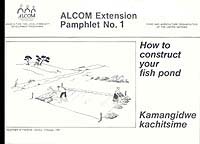
 | ALCOM |
| The designations employed and the presentation of the material in this publication do not imply the expression of any opinion whatsoever on the part of the Food and Agriculture Organization of the United Nations concerning the legal status of any country, territory, city or area or of its authorities, or concerning the delimitation of its frontiers or boundaries. |
Preface During 1987–90, ALCOM assisted the Department of Fisheries, Zambia, in introducing fish farming in the country's Eastern Province. Visits were made to select villages, slides were shown to interested farmers, advice and guidance on various aspects of fish farming including site selection and pond digging were provided, and the spread of fish farming was monitored. The use of local materials and tools for fish farming to ensure easy replicability was encouraged. This pamphlet is part of a series of three. They are designed to follow up on the earlier extension work and consolidate it. Though the pamphlets have been designed for use in Eastern Province, they can be adapted or modified for use elsewhere in Zambia, and in southern Africa. The sketches for this pamphlet were done by Mr C N Kanoso. Planning and design of the pamphlet and the text were organized by Mr J C Mutale, Mr H W van der Mheen and Ms J van der Mheen Sluijer. ALCOM is a regional FAO aquaculture programme which covers countries that belong to SADCC (Southern African Development Coordination Conference) -- Angola, Botswana, Lesotho, Malawi, Mozambique, Namibia, Swaziland, Tanzania, Zambia and Zimbabwe. The programme is funded by SIDA (Swedish International Development Authority) and executed by FAO (Food and Agriculture Organization of the United Nations). |
| Published by ALCOM, c/o FAO, P O Box 3730, Harare. Tel: 724985, 734797. Telex: 26040 FAO ZW. Fax: 263-4-729563. |
WHERE TO PUT YOUR FISH POND
You must choose a good place to put your fish pond.
KOMWE M'NGAIKE CHITSIME
M'yenela kutsankha malo yabwino yachitsime chanu.
Choose a sunny place near water such as a stream or a dambo area where the water in the soil will fill up your pond. It is best to choose a piece of land that has a gentle slope.
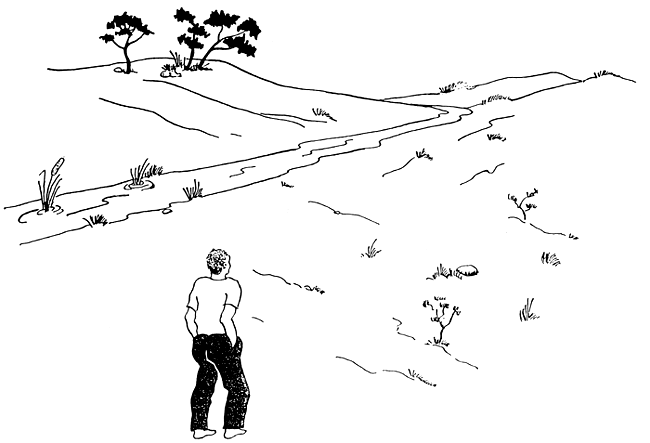
Sankhani malo abwino amene alandila dzuwa pafupi ndi madzi ambili. Ndipo pa msondo wabwino.
Like for making clay pots, you have to test if you have pond soil. You take a handful of soil from the surface, make it a little wet and squeeze it into a ball.

Dothi liyenela kukhala monga lopangila mbiya ndipo muyenela kuliyetsa. Tolani dothi kumanja ndikulibvumbwitsa, m'likanyekanye.
Throw the ball in the air and catch it. If it sticks together it is good soil and it will hold water.
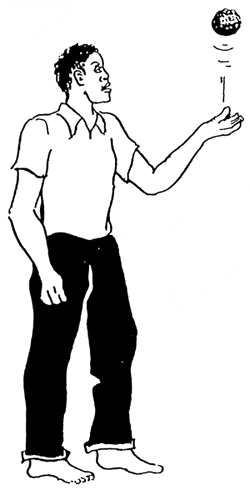
Muliponye m'mwamba ndikuliwankha. Ngati lagwilana ndilabwino cifukwa lizasunga madzi.
Now dig a hole as deep as your waist.
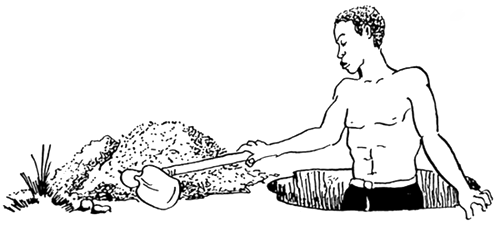
Kumbani dzenje kufika mchiuno.
Test the soil from the bottom of the hole in the same way as before.
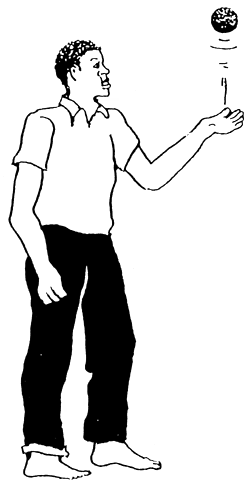
Yetsani dothi lapansi monga lapamwamba.
YOU SHOULD MAKE ANOTHER TEST TO BE SURE THAT THE SOIL WILL HOLD WATER.
M'YENELA KUONETSETSA KUTI DOTHI LOSE NDILA BWINO LOGWILA MADZI.
Early in the morning you fill the hole with water. Fill it to the top.
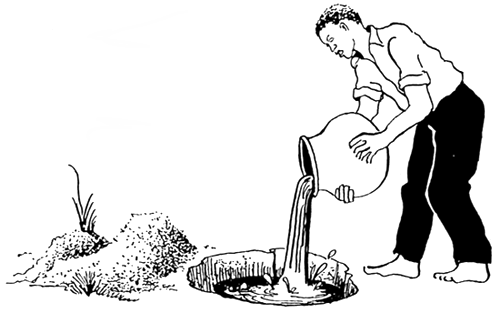
M'mawa-mawa mudzaze madzi mchitsime chanu mpaka palulu.
Cover the hole with branches. By the evening some of the water will have sunk into the soil. Then fill the hole again with water.
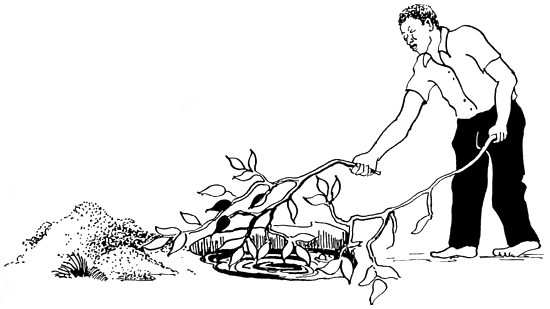
Ikamoni mitsambo ya mtengo m'chitsime kufika m'madzulo madzi ena adzaphwilila. Conco muikemo madzi ena.
If most of the water is still in the hole the next morning, the soil will hold enough water to build a fish pond.
Then, this is a good place to dig your pond.
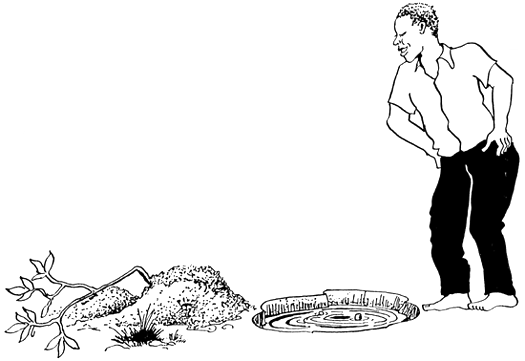
Ngati madzi ambili akalimo kufika m'mawa-mawa ndiye kuti dothi ndilabwino ligwila madzi.
Ichi chitsonyeza kuti dothi ndilabwino kukumbapo chitsime.
HOW TO DIG YOUR POND
KAKUMBIDWE YA CHITSIME
Mark out the size of the pond on the area you have chosen.
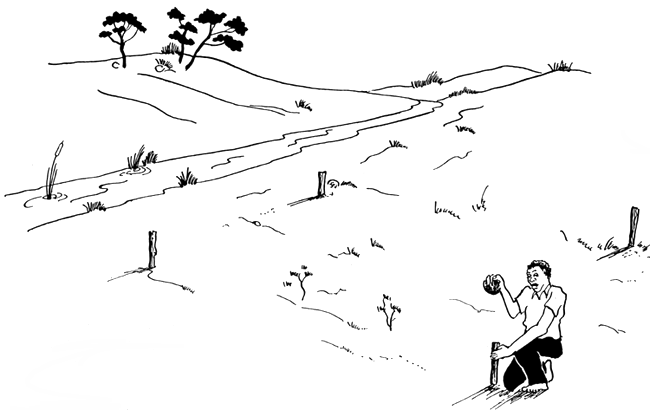
Lembani saize (kukula) ya chitsime chomwe mufuna pamalo amene mwasankha.
You can make a pond any size you want. The construction of a big pond takes more time than the construction of a small one, but from a big pond you will get more fish. For example, a pond which is 10 metres wide and 10 metres long will give you about 200 fish. A pond of 15 by 15 metres gives approximately 450 fish.
Chitsime chingakhale cha saizi ili yose yomwe inu mufuna, koma chachikulu chitenga nthawi yaikulu kusiyana ndi chaching'ono angakhale kuti mungapeze nsomba zambili pa chitsime chachikulu. Mwachitsanzo chitsime chokula mamita khumi limodzi (10 metres) ndi mita khumi limodziso mungapeze nsomba zokwanila madzana awiri (200). Chitsime chokula mamita khumi limodzi ndi asanu (15 metres) ndi khumi limodzi ndi asanu muutali (15m × 15m) mungapezenso nsomba zokwanila madzana anai ndi makhumi asanu (450).
One metre is about the same as one big step. So for measuring the size of your pond, you can count the number of steps.
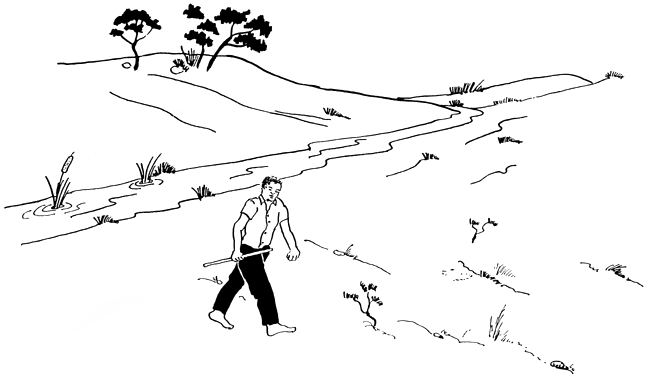
Mita imodzi ilingana ndi nthangalalo imodzi ndipo popima saizi ya chitsime chanu mungatsewezetse minyendo kupima nthangalalo.
Clear the area where you want to build your pond of all trees, bushes and grass and take away the roots.
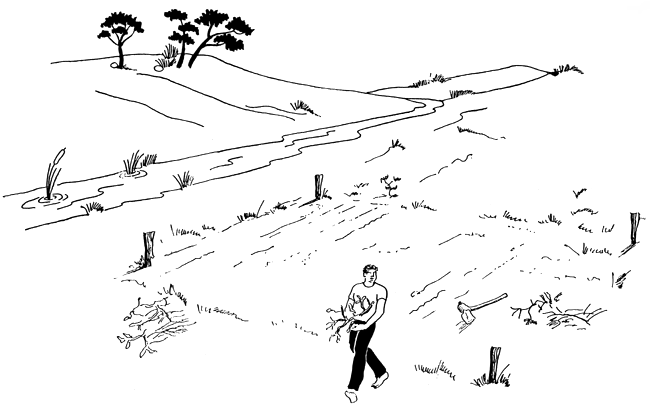
seulani pamalo pomwe mufuna kukumba chitsime, chotsani maudzu ndi kugobola mitengo.
Take away the topsoil from all the cleared area and put it aside. The grass and roots in the topsoil may rot and will cause leakages in your dikes. Therefore, you should not mix this topsoil with the soil used for making dikes.

Chotsani dothi lapamwamba ndikuliika padela. M'sasakanize dothi lapamwamba ndi lopangila m'mbali mwachitsime chifukwa ngati udzu ndi mizyu vaola vipanga mibowo.
Now you can start digging your pond.
Manje m'ngayambe kukumba chitsime.
As you dig the soil out, put it on the place where you want to build the dikes. When you come to roots, take them away as much as you can.
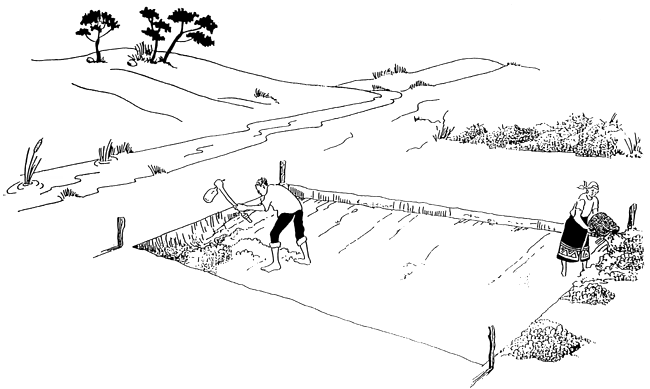
Pokumba ikani dothi kumbali imodzi
Whenever the soil you have put on the dikes reaches half as high as your knees, pack it down tightly. You can compact by beating the soil with an earth stamper, a heavy plant or a tree trunk.
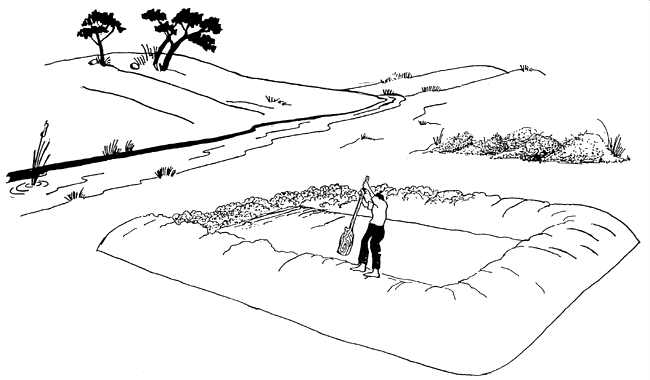
Ngati limene mukumba lifika pafupi ndi m'nkhokola sindilani ndi pulanga loko mtengo obaza kapena chinthu chili chonse cholema.
If the soil is dry you should pour water on it before you start compacting.
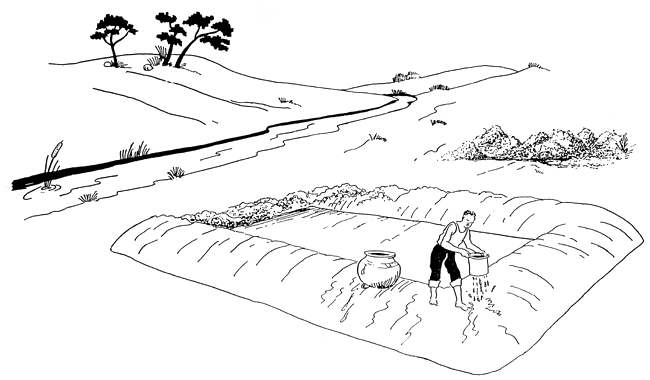
Ngati dothi ndilouma mzithilapo madzi mkalibe kuyamba kukumba.
Dig out more soil, put it on the dike and compact it tightly as before. It is important that you compact your dikes, it will make them strong like the floors of houses.

Kumbani kwambili ndiposo sindilani dothi lokumbidwalo. Ici chithandiza kuti chipupa cha chitsime chanu chikotse monga pansi panyumba.
Do not make the sides of the dikes too steep. They should have a slope like the roof of a house. That makes them stronger.
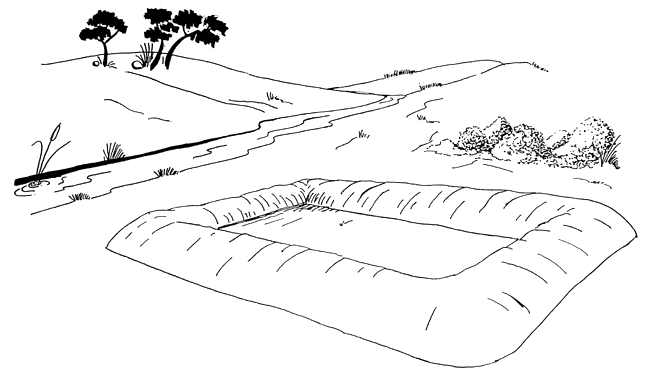
Dothi limeneli lamumbali mwachitsime likhale losondoka monga m'tenje was nyumba kuti vikose.
In the shallow end, the water in your pond will have to be about knee-deep.
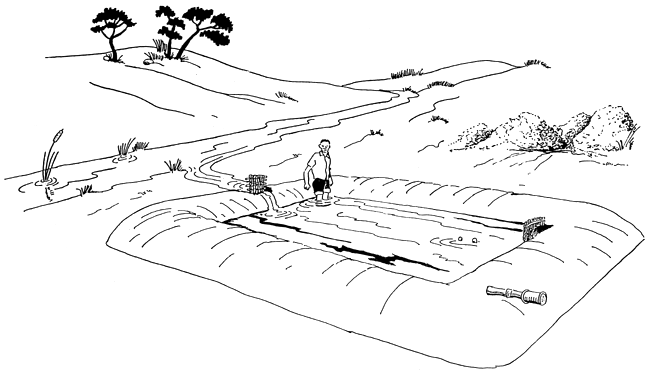
Kumalo ko yambila msondo kuyenela kukhala ndi madzi ofika m'nkhokola.
In the deep end, the water will have to be waist-deep. By doing so all the fish will come to the deeper side when you harvest your pond and this makes cropping easier.

Kuja konoka madzi afike mchiuno. Pachifukwa ichi nsomba zizabwela kumalo onoka pobweza ndipo ichi chithandiza kugwila nsomba kosabvuta.
Before you complete the dike at the deep end, you will need to make an overflow to keep the dikes from overflowing when there is too much water in the pond. Place the overflow at about 20 centimetres from the top.
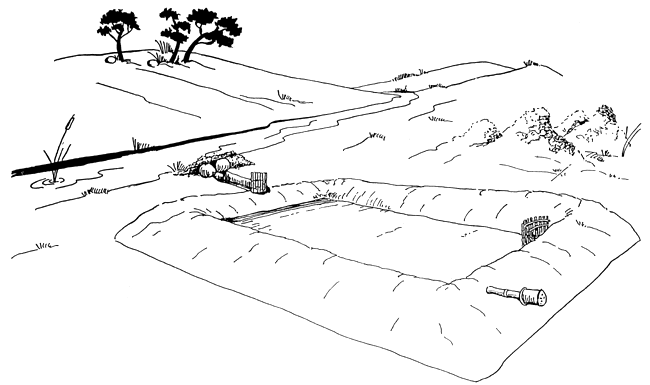
Pamene mukalibe kutsiliza nchito yotsindila cipupa cha kumbali yonoko m'funika kupanga kamugelo kochosela madzi ngati chitsime chanu chazala ngako.
An overflow is some kind of pipe through which water can escape. As you can see in the picture, it can be very simple. Maybe you even have better ideas of what to use.

Kam'gelo kameneka kakhale monga kam'paipi momwe mzipita madzi. Monga muona pachithunzi ici ndikotsabvuta.
If the water for your fish pond comes from a stream, you will also have to make an inlet at the shallow end. The easiest way is a small ditch which should be situated high enough so that the water can run towards your pond and fill it.
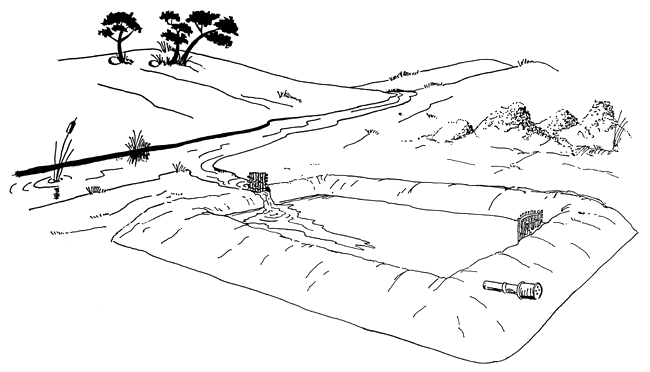
Ngati madzi ochokela m'mtsinje muyenela kupanga kam'gelo kena kongenetsa madzi kuja kotsanoka. Kam'geloka kakhale pamwamba kuti madzi azipita mbali zonse mwansanga.
If the water comes from a stream, be careful to keep out wild fish from your pond. You can do this by using a screen on the inlet. When you have put in an overflow, you should also make a screen on the overflow to prevent your fish from escaping. In the picture you will find some ideas on what you can use as a screen.
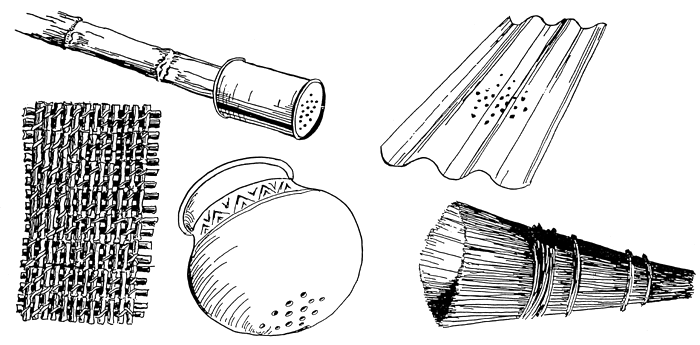
Ngati madzi achokela m'mtsinje onani kuti sangenetsa zilombo zi somba monga nsomba zakunja. Muyenela ku panga chosefela chomwe chingaletse nsomba kulowa kapena kuchoka. Izi mungazione pachithunzi ichi.
Now that you have finished digging your pond, compacted the dikes and placed the overflow and inlet, you can put the topsoil you had set aside on the dikes.
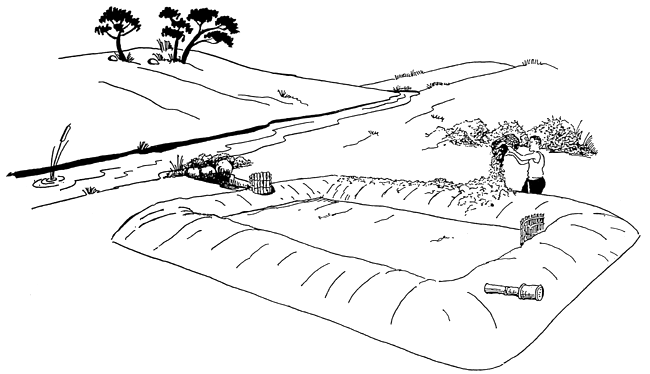
Ngati mwatsiliza kukumba tsindilani dothi mu zipupa za mwa chitsime ndikupanga bwino bwino tumigelo tolowetsa ndikutulutsa madzi. Mungaike dothi lija lapamwamba pomwe mwasindila.
Then plant grass on the dikes to stop the soil from being washed away by the rain.

Byalani uzu pa zipupa za chitsime chanu chifukwa ichi chizateteza dothi kukokoloka ndi vula.